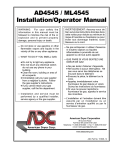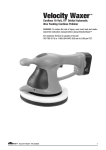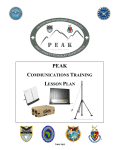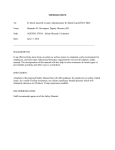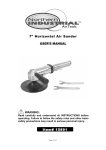Download Compressed Earth Brick Press: User Manual
Transcript
Compressed Earth Brick Press: User Manual Contents Operation, Safety, and Maintenance 2 Hydraulic Fluid Power - General Safety Considerations 2 Moving Parts Safety Issues Heavy Weight Issues 3 3 Electronics Safety 3 Power Unit Safety3 Workflow Safety Issues 4 Weather Issues 4 Safety Features 4 Operation and Maintenance Procedures Maintenance and Repair6 Troubleshooting 7 User Responsibilities Open Source Ecology 7 5 1 Compressed Earth Brick Press: User Manual Operation, Safety, and Maintenance The User should acknowledge first that the Machine is a heavy piece of powered equipment, and poses inherent risks of injury or death that may result from improper usage or accidents. If all operating, safety, and maintenance procedures are followed, these risks are minimized or nonexistent. Inherent risks for the Machine arise from several sources. First, this is a machine powered by hydraulic fluid pressure, as produced by an external power source. Second, there are risks associated with moving parts. Third, there are risks associated with the heavy weight of the machine. Fourth, there are risks associated with the electrical power delivery to the machine electronics. Fifth, there may be risks associated with the power unit used with the machine. Sixth, the machine is typically used under a workflow involving other heavy machinery used for ancillary purposes such as soil preparation and loading. All these risks, while insignificant under normal operating conditions, can be injurious or deadly when proper procedures are not followed. Hydraulic Fluid Power - General Safety Considerations Hydraulic fluid power is used to power the machine. The machine is plugged into a power source via hydraulic hoses. The hydraulic power is generated by an external power unit, wherein a gas, diesel, electric, or other engine drives a hydraulic pump - which in turn pumps hydraulic fluid at high pressure through the hydraulic circuit. Depending on the power unit used, the fluid going into the machine may be anywhere from 2000 to 5000 PSI. This is extremely high pressure, and may be a danger to the user in case of direct contact. For example, death or injury may result from a hose rupturing and hot, hydraulic fluid hitting a person directly. It should be noted that hydraulic fluid under normal working conditions reaches 180F (82C) in temperature, which can produce a burn on the body, and will cause serious human body damage if delivered under pressure. Moreover, loose hoses may spring back and forth as pressure is applied and released within them, so there is some danger of being hit by a flexing hose. For safety, one should take several steps. First, hydraulic hoses, and especially exposed hydraulic hoses, should be inspected for their integrity. When a hose is damaged or worn out, it should be replaced immediately. Second, all hoses should be secured such that they move as little as possible upon pressure being cycled. Moreover, hoses should be secured in such a fashion that they do not rub against each other or against other metal parts. This prevents them from wearing out - as the rubber covering will be abraded readily, and the metal braids inside will be damaged subsequently, placing the hose at a risk of rupture. Fourth, one should stay away from the hydraulic hoses as far as possible during machine operation and one should wear safety glasses when near the machine in case of hose rupture. Hose rupture is the only risk that the machine presents to the user even when the user is not touching the machine in any way. Open Source Ecology 2 Compressed Earth Brick Press: User Manual Moving Parts Safety Issues The Machine has 3 moving parts: the main cylinder and its assembly; the secondary cylinder with the soil-loading drawer; the soil shaker. Any user should stay behind the Safety Rope at all times when the machine is in operation. Users with long hair should make sure that they do not catch their hair in the grate shaker motor. If the user puts their hand in the way of any pinch point, the user runs a serious risk of losing a limb immediately, and death in the worst case. The force of the main cylinder is about 40,000 lb., and the force of the secondary cylinder is about 10,000 lb. Also, note that the hoses flex like a stiff muscle when pressurized, so make sure that you are aware of this motion. Heavy Weight Issues The machine weighs about 1600 lb. total. The user should avoid any situation in which there is a risk of the machine toppling on top of the user, as injury or death by crushing may occur. This is especially true if the machine is being moved. The machine is designed to be moved by forklift, with forklift arms placed under the machine arms closest to the main cylinder frame. Whenever moving the machine, the User should secure the Machine to the forks with chains. When placing the machine on the ground, one should select a site with the floor as level as possible, to minimize the possibility of the machine moving. The ground directly under the 10”x10” feet of the machine should be leveled so that the feet lie flat on the ground. Electronics Safety The Machine electronics are powered by 12 volts via the battery clamps. Typically, the battery that comes with the power unit is tapped. One should be aware of the standard dangers of electric shock when working with 12V batteries. Power Unit Safety The power unit may emit loud noise, in which case any user in close proximity should wear ear protection. Standard safety procedures should be taken when dealing with engines - such as staying away from moving parts, not using indoors for risk or gaseous poisoning, and considering the risk of flammability and explosion associated with liquid or other fuels. Since the power unit connects to the Machine via hydraulic hoses, care should be taken not to step on or trip over them. Care should be taken not to damage the hoses, and to make sure that hose quick connections are securely coupled when starting the machine. There is a risk of damaging the power unit in case of hoses being disconnected if the power unit does not have an internal pressure relief bypass. If there is no internal pressure relief and a hose is not connected, hoses on the power unit run a risk of rupture due to high pressure buildup upon startup of the power unit. Moreover, users with long hair should take precautions to make sure that their hair does not get caught in any moving parts of the power unit. Open Source Ecology 3 Compressed Earth Brick Press: User Manual Workflow Safety Issues The workflow of a CEB production operation may involve a number of people and heavy equipment. The User should stay away from the working path of tractors or other heavy equipment, and wear protective eyewear and a hardhat. The general workflow immediately surrounding the machine may consist of: (1), one or more tractors loading the Machine hopper from the front of the machine; (2) one or more people unloading the machine from the opposite side. The workflow should include a set of rollers or some table surface, such that the people unloading the machine are 20 feet or farther away from the hopper of the machine. This helps to prevent any accidents related to the loader-tractor operator losing control of the tractor and ramming into the Machine, and the machine hitting people on the opposite side. The Machine soil-loader-tractor operator should attend to coming to a full stop prior to releasing the bucket to assure a controlled soil drop, and to avoid bumping the machine. The hopper shaker will go on and off automatically according to the programming of the Machine, so the User should be aware of this so as not to be startled by the vigorous shaking. Weather Issues There are inherent risks associated with operating the machine in foul weather. One should never operate the machine when there is lightning in the area, and one should avoid pressing operations when it is raining or wet. Slippery ground may be dangerous when one falls and trips onto the machine and slipping may be dangerous when one is carrying a load of blocks. Each block weighs 10-20 lb., so one should wear solid boots to prevent injuries related to bricks falling. During extremely hot weather, one should pay attention to the temperature of the power unit and the hydraulic fluid, and discontinue operations if the hydraulic fluid gets too hot. In extremely cold weather, one should first warm the machine up by running on idle, or undue stress result in premature hydraulic hose rupture. Safety Features The Machine is built with a number of safety features. Pressure Reliefs - The Machine features 2 pressure relief valves to release hydraulic system pressure above 2200 PSI, in order to prevent pressure buildup that could potentially rupture hydraulic hoses. The pressure reliefs may be activated upon: (1), jamming or other unforeseen machine condition; (2), end of the compression stroke of the main cylinder; (3) cylinders reaching their limits. The pressure reliefs are essential to the safe and efficient operation of the Machine, and they are activated on a continuous basis. The main pressure relief is located on the main hydraulic hoses, and the second pressure relief is located on the solenoid valve. Open Source Ecology 4 Compressed Earth Brick Press: User Manual Kill Switch - the safety rope around the machine, which also serves as the power cord for the automatic controls, serves as a kill switch. When this rope is pulled from any of the 3 sides other than the control panel side, power is shut off to the machine. Another power switch is located on the bottom of the controller box. Hopper Orientation - The hopper is oriented in such a fashion that the tractor-loader approaches the machine from one side, and bricks are ejected from the other side. The machine is designed for use with brick rollers, such that brick rollers should be attached to ejection side of the Machine. With brick rollers in place, people are removed away from the machine by a recommended distance of 20 feet or more. Moving part covers - All moving parts are inaccessible to the user when the user remains behind the safety rope. The main cylinder is within the main pressing frame, shielded on 4 sides from the user. The hopper shaker eccentric is located behind a safety shield, away from users. Machine testing code - cylinder, bypass valve, and shaker motor functions may be tested independently with supporting control code to determine proper functioning of these components Indicator light on the power switch - Machine on-condition may be determined visually by observing whether the power switch is lit. Indicator lights on control circuit - For troubleshooting purposes, indicator lights on the solenoid driver board light up to indicate which solenoid sections are activated. Wear protection - There are 4 adjustment bolts to keep the press foot positioned away from the walls of the compression chamber. This minimizes and at best eliminates metal-on-metal contact in the compression chamber, to extend machine life. The hopper loading drawer rides on v-groove rollers above the table surface, so wear is minimized on the drawer surfaces. Operation and Maintenance Procedures For safe operation of the machine, all the points in the above Operation, Safety, and Maintenance section must be kept in mind and followed. In addition, here are further, specific operation and maintenance points: Assembly: Follow the CEB Assembly Video to put the machine together. Complete the Machine assembly prior to testing and running the machine. First Run and Setup: Follow the Initial Setup and Testing Procedure on the wiki, and verify that the relief valve, 2 cylinders, and hopper shaker are in working order. Open Source Ecology 5 Compressed Earth Brick Press: User Manual Inspect all hoses and hose connections. Tighten any bolts on the main frame section and any other bolts that may have loosened during shipping. Follow all points relevant to every machine run in the next section. Set the brick thickness and machine speed as needed, by following the Machine Adjustments section. Every Run: Stay behind the safety rope at all times during operation, and remain 20 feet away from the machine unless you need to be closer. Inspect all hydraulic hoses for wear prior to beginning of brick production, and replace any defective hoses. If the machine locks up for any reason, turn the power off immediately, identify and correct the problem, and restart machine. Do not touch the machine while it is in operation. If you have long hair, make sure that it is kept away from the hopper shaker motor. Your hair may get wrapped up in the motor and pull you in, potentially killing you. Do not loosen the leg bolts when the machine is standing. Machine level adjustment should be performed only when a set of tractor forks or other jack is in used to prevent the machine from falling down when the machine leveling is being adjusted. Wear safety goggles and a hard hat during machine operation, and ear protection in case the power unit makes a lot of noise. Listen to the relief valve system to make sure that it is working properly. You should hear a hiss every time the bypass condition happens. If you hear that the power source is bogged down or if it stops, disable the Machine immediately and identify the issue. Check all accessible bolts by hand or visually to make sure than they have not loosened during operation. Open Source Ecology 6 Compressed Earth Brick Press: User Manual Maintenance and Repair There is little maintenance that needs to be done to the machine. This is due primarily to the absence of a power unit on the machine. For storage, take off the hopper grate and clean soil from the machine. Store the machine indoors to prevent rusting. Cap the hose ends so that dirt does not get into the hoses. If any parts become damaged structurally for any reason, assess the damage and replace the part if needed. All parts are either stock steel or off-shelf components. Most of the machine features bolt-together, design-for-disassembly, and most parts may be replaced readily. The entire machine can be taken apart in about 5 hours for study or refurbishing, and as long as the machine is kept free from rust, it should last from generation to generation. We recommend a new paint job every 10 years, including the inside the main frame. The inside of the compression chamber is the only part that may wear out in time. Replacement of the front and back u-channel pieces involves approximately a 2 hour job involving the drilling of holes and minor welding, and replacement of the side wear plates involves torching off the old ones and welding on new ones, which is about a 2 hour job if the machine frame is already taken apart. Material costs for these repairs involve a total of about US$40. Troubleshooting For the machine to operate properly: 1. 2. 3. 4. 5. 6. Hydraulic power must be available by a power source. Hydraulic power must be delivered to the actuator. Electrical power must be available from an electrical source. Electrical power must be delivered to the power usage points. The logic system must be providing control logic. Control logic must receive position feedback from sensors. To troubleshoot the hydraulic system - see Hydraulic System Troubleshooting Electric System Troubleshooting: 1. Is the power turned on? 2. Is there a master power switch that is turned off? 3. Is there an indicator light that tells that power is on? 4. Check that an electric source has electric power 5. Check polarity of connection to power source. 6. Check the connection from the electric power source to wires. 7. Check the integrity of wires. 8. Check the connection of wires to the component that uses power 9. Check for loose connections on the device receiving power 10.Check that a device is grounded properly Open Source Ecology 7 Compressed Earth Brick Press: User Manual 11.Check for frayed or broken insulation 12.Check whether a fuse is burned out 13.Check if any safety component or breaker is tripped 14.Check whether voltage is being delivered to a device Mechanical System Troubleshooting: 1. 2. 3. 4. 5. 6. 7. Check that bearings are rolling smoothly After tightening bearings and shafts, make sure that shaft is aligned and it spins freely Check for obstruction on any moving parts, such as rocks, metal, or wood branches Check that bolts are secured and not loose Check for any broken parts by visual inspection Check for signs of wear or rubbing of mechanical parts Check that parts are greased as needed User Responsibilities The User takes on the full responsibility of using the plans to build a CEB machine, by ensuring that the User follows all CEB build, safety, maintenance, and operation procedures. It is the duty of the User to accept that accidents and unforeseen circumstances may occur by using, and that such happenings may place the User in danger of injury or even death. The User agrees to not hold OSE liable for any accidents or deaths, and the User agrees to not pursue any legal action against OSE and his or her agents and collaborators in the case of harm, injury, or death resulting from use of the Machine, regardless of the cause or reason for the accident. It is the duty of the User and his/her collaborators or work crew to read and understand the Assembly, Setup and Testing Procedure, Machine Adjustment, Troubleshooting, and all of the above safety, maintenance, and operation procedures. Furthermore, the User agrees to not solicit the services of any agents, assigns, or other third parties to pursue legal action against the Producer in the case of accidents or death related to use of the Machine. If the User allows any other person or group to use the machine or participate in brick production, the User likewise agrees to take on the full responsibility and liability associated with any harm or injury that may happen to anyone involved in using the Machine, and shall hold the Producer in indemnity. Therefore, the User hereby agrees to release and forever discharge OSE from any and all liability, claims, and demands of whatever kind either in law or in equity, which arise or may hereafter arise from the building or use of the Machine by: (1), the User, (2), others involved with the User in the build or use of the Machine, and (3), others to whom the User grants use of the Machine. The User furthermore agrees and understands that this contract discharges OSE from any liability or claim that the User may have against OSE with respect to bodily injury, personal injury, or property damages that may result from the User’s and Beneficiary’s production or use of the machine, wherever the Machine may be used. The User also understands that the Producer does not assume any responsibility for or obligations to provide financial or other assistance, including but not limited to medical, health, or disability insurance in the event of injury or loss – unless OSE agrees to help the User or Beneficiary out of voluntary, good faith and honor. Open Source Ecology 8









